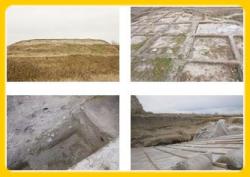|
| Details about “Yunatsite” mound and the oldest European civilization |
|
|
 More and more evidence confirm a very brave thesis, according to which the Balkan Peninsula, rather than ancient Mesopotamia, is the cradle of our civilization. The evidence of a little known culture which preceded the Egyptian and even the Sumerian cultures attracts the attention of the scientists, thus turning the perceptions of antiquity upside down. Remains of this ancient society have been gradually emerging from the ashes of the human history to take us some 6-7 millennia back in time when a highly-developed unknown civilization flourished on our lands. We are talking about a period which preceded the Sumerian one at least one millennium.
More and more evidence confirm a very brave thesis, according to which the Balkan Peninsula, rather than ancient Mesopotamia, is the cradle of our civilization. The evidence of a little known culture which preceded the Egyptian and even the Sumerian cultures attracts the attention of the scientists, thus turning the perceptions of antiquity upside down. Remains of this ancient society have been gradually emerging from the ashes of the human history to take us some 6-7 millennia back in time when a highly-developed unknown civilization flourished on our lands. We are talking about a period which preceded the Sumerian one at least one millennium.
One of the most emblematic evidences of this mysterious civilization is the gold of the Chalcolithic Necropolis of Varna (from 4,400-4,100 BC), also known as the oldest processed gold worldwide. Today the exquisite adornments visit the most popular world museums, making Bulgaria famous across the globe. The prehistoric settlement near the town of Provadia (Southeastern Bulgaria) dates back to the same period. It emerged near an ancient Black Sea salt cellar. Its residents prospered due to the salt which was once the main monetary unit. Another ancient place is the so-called Lake Town situated on the island near the coastal village of Durankulak where the remains of the oldest stone architecture in Europe were found. It is at least 7,000 years old.
The village mound near the city of Pazardjik (southern Bulgaria) named “Yunatsite” (the Heroes) also dates back to that period. Archeologists have been researching this region for years, where many traces of the Chalcolithic period were found. Currently the team of Associate Professor Yavor Boyadzhiev is uncovering a four meter thick fortress wall, which once encircled streets, residential buildings, etc. “We suppose that this is the oldest town in Europe”, Associate Professor Boyadzhiev explains, adding that the earliest finds of the mound date back to the 5th millennium BC. The town covered an area of 12-15 hectares. It is interesting to note that settlements with similar dimensions emerged on the lands between Euphrates and Tiger rivers some 1,500 years later. “According to explorers who worked in Mesopotamia, settlements with a total area of over 0.7-0.8 hectares were regarded as towns”, Associate Professor Boyadzhiev says and adds:
“Judging even on the standards of Mesopotamia, we are talking about an ancient town. We found a big settlement with a citadel on its highest part. This was the principle of construction of each ancient town- the existence of a fortified place inside the town which had to protect its population in case of emergency. The town elite and all craftsmen used to live there. In “Yunatsite” ancient complex we found evidence of a very highly-developed culture which existed ages before the emerging of the oldest towns we know about. This is an incredible historical monument where life continued from the 5th millennium BC until the Medieval Period, i.e. for 6 whole millennia!”
What did this ancient town look like? Archeologists suppose that its inhabitants were mainly living on fishing in the nearest Topolnitsa River. They lived in cozy houses which were made of wooden fencing plastered up with clay, rather than in huts. Their homes were 80-120 square meters large. There were two-story buildings, too. “These houses did not differ a lot from the ones build in Bulgarian villages 70-80 years ago” Associate Professor Boyadzhiev explains. The ceramic pieces found at this place, including dozens of fantastic figurines of birds were displayed at the Museum of History in the town of Pazardzjik.
So far the archeologists have found two streets only. The central part of the ancient citadel is yet to be explored. “We came across signs on some of the pottery found here, which makes us believe that they were part of an ancient script”, Associate Professor Boyadzhiev claims. In fact similar evidence of ancient script was found in the Balkan Mountain Range near Vratsa (northwestern Bulgaria).
“We are talking about the Stone-Copper Age when the Balkans was the peak of the ancient civilization”, Associate Professor Boyadzhiev further explains. “There are many village mounds in Bulgaria and many of them could turn similar to the “Yunatsite” Mound. Biggest evidence of this civilization comes from the Chalcolithic Necropolis of Varna. However, I think we can soon start talking about some kind of ancient proto state, which was perhaps the oldest country worldwide. I am talking about the whole culture which spread between the Carpathian Mountains and the Aegean Sea. We collected a lot of evidence which makes us believe that these ancient people were very well-organized, which presupposes centralized management.”
In the beginning of the 4th Millennium BC these lands were invaded by wild steppe tribes who literally destroyed this little known culture. Charred human skeletons amidst the ruins of their homes and remains of the weapons that killed these people confirmed this sad thesis. The enemy invasion caused the extinction of the settlement of “Yunatsite”, as well as the whole flourishing Chalcolithic civilization, which inhabited these lands. Later during the Bronze Age life emerged again on these lands, but the cultural development was miles lower. Golden treasure, ceramic fragments and legends are the only things lThat is eft from the one-time brilliance and prosperity of the Chalcolithic people is but a golden treasure, ceramic fragments and . . . legends.
http://bnr.bg |
| Saturday, Nov 01, 2014 |
|
|
|
|
| » RENTALS |

|
|
|
| Office Space |
€ 1 000 |
|
| Location: |
Veliko Tarnovo |
|
|

|